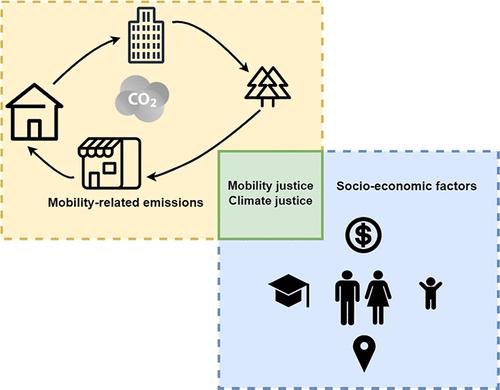当前位置:
X-MOL 学术
›
Environ. Sci. Technol.
›
论文详情
Our official English website, www.x-mol.net, welcomes your
feedback! (Note: you will need to create a separate account there.)
Personal Mobility Choices and Disparities in Carbon Emissions
Environmental Science & Technology ( IF 10.8 ) Pub Date : 2023-06-01 , DOI: 10.1021/acs.est.2c06993 An Wang 1 , Scott Weichenthal 2 , Marshall Lloyd 2 , Kris Hong 2 , Shoshanna Saxe 3 , Marianne Hatzopoulou 3
Environmental Science & Technology ( IF 10.8 ) Pub Date : 2023-06-01 , DOI: 10.1021/acs.est.2c06993 An Wang 1 , Scott Weichenthal 2 , Marshall Lloyd 2 , Kris Hong 2 , Shoshanna Saxe 3 , Marianne Hatzopoulou 3
Affiliation

|
The promotion of sustainable mobility choices is a crucial element of transport decarbonization. It requires a fundamental understanding of the choices available to urban dwellers and of the equity and justice implications of green mobility solutions. In this study, we quantified personal mobility-related greenhouse gas (GHG) emissions in the Greater Toronto and Hamilton Area (GTHA) and their associations with various land use, built environment, and socioeconomic factors. Our study captured personal, household, and neighborhood-level characteristics that are related to high emissions and disparities in emissions across the study region. We observed that the top 30% of emitters generated 70% of all transportation GHG emissions. Household income, family size, and vehicle ownership were associated with increased mobility emissions, while increased population density was associated with lower emissions. The percentage of visible minorities in a neighborhood was associated with lower emissions, but this effect was small. We further contrasted the spatial distribution of traffic-related air pollution with mobility GHG emissions. The results suggest that individuals who emit less GHG live in areas with higher air pollution. A computer vision-based model was used to predict GHG emissions from aerial images of neighborhoods, demonstrating that areas with high land use mixture were linked to a lower generation of mobility-based GHG emissions.
中文翻译:

个人出行选择和碳排放差异
促进可持续交通选择是交通脱碳的关键要素。它需要对城市居民的选择以及绿色出行解决方案的公平和正义影响有基本的了解。在这项研究中,我们量化了大多伦多和汉密尔顿地区 (GTHA) 与个人出行相关的温室气体 (GHG) 排放及其与各种土地利用、建筑环境和社会经济因素的关系。我们的研究捕捉了与研究区域的高排放和排放差异相关的个人、家庭和社区层面的特征。我们观察到,前 30% 的排放者产生了所有交通运输温室气体排放量的 70%。家庭收入、家庭规模和车辆拥有量与交通排放增加有关,而人口密度的增加与排放量的减少有关。社区中可见少数族裔的比例与较低的排放量有关,但这种影响很小。我们进一步将交通相关空气污染的空间分布与流动温室气体排放进行了对比。结果表明,温室气体排放量较少的人生活在空气污染较高的地区。基于计算机视觉的模型用于预测社区航空图像的温室气体排放量,证明土地利用混合程度较高的区域与较低的基于流动性的温室气体排放量有关。我们进一步将交通相关空气污染的空间分布与流动温室气体排放进行了对比。结果表明,温室气体排放量较少的人生活在空气污染较高的地区。基于计算机视觉的模型用于预测社区航空图像的温室气体排放量,证明土地利用混合程度较高的区域与较低的基于流动性的温室气体排放量有关。我们进一步将交通相关空气污染的空间分布与流动温室气体排放进行了对比。结果表明,温室气体排放量较少的人生活在空气污染较高的地区。基于计算机视觉的模型用于预测社区航空图像的温室气体排放量,证明土地利用混合程度较高的区域与较低的基于流动性的温室气体排放量有关。
更新日期:2023-06-01
中文翻译:

个人出行选择和碳排放差异
促进可持续交通选择是交通脱碳的关键要素。它需要对城市居民的选择以及绿色出行解决方案的公平和正义影响有基本的了解。在这项研究中,我们量化了大多伦多和汉密尔顿地区 (GTHA) 与个人出行相关的温室气体 (GHG) 排放及其与各种土地利用、建筑环境和社会经济因素的关系。我们的研究捕捉了与研究区域的高排放和排放差异相关的个人、家庭和社区层面的特征。我们观察到,前 30% 的排放者产生了所有交通运输温室气体排放量的 70%。家庭收入、家庭规模和车辆拥有量与交通排放增加有关,而人口密度的增加与排放量的减少有关。社区中可见少数族裔的比例与较低的排放量有关,但这种影响很小。我们进一步将交通相关空气污染的空间分布与流动温室气体排放进行了对比。结果表明,温室气体排放量较少的人生活在空气污染较高的地区。基于计算机视觉的模型用于预测社区航空图像的温室气体排放量,证明土地利用混合程度较高的区域与较低的基于流动性的温室气体排放量有关。我们进一步将交通相关空气污染的空间分布与流动温室气体排放进行了对比。结果表明,温室气体排放量较少的人生活在空气污染较高的地区。基于计算机视觉的模型用于预测社区航空图像的温室气体排放量,证明土地利用混合程度较高的区域与较低的基于流动性的温室气体排放量有关。我们进一步将交通相关空气污染的空间分布与流动温室气体排放进行了对比。结果表明,温室气体排放量较少的人生活在空气污染较高的地区。基于计算机视觉的模型用于预测社区航空图像的温室气体排放量,证明土地利用混合程度较高的区域与较低的基于流动性的温室气体排放量有关。











































 京公网安备 11010802027423号
京公网安备 11010802027423号